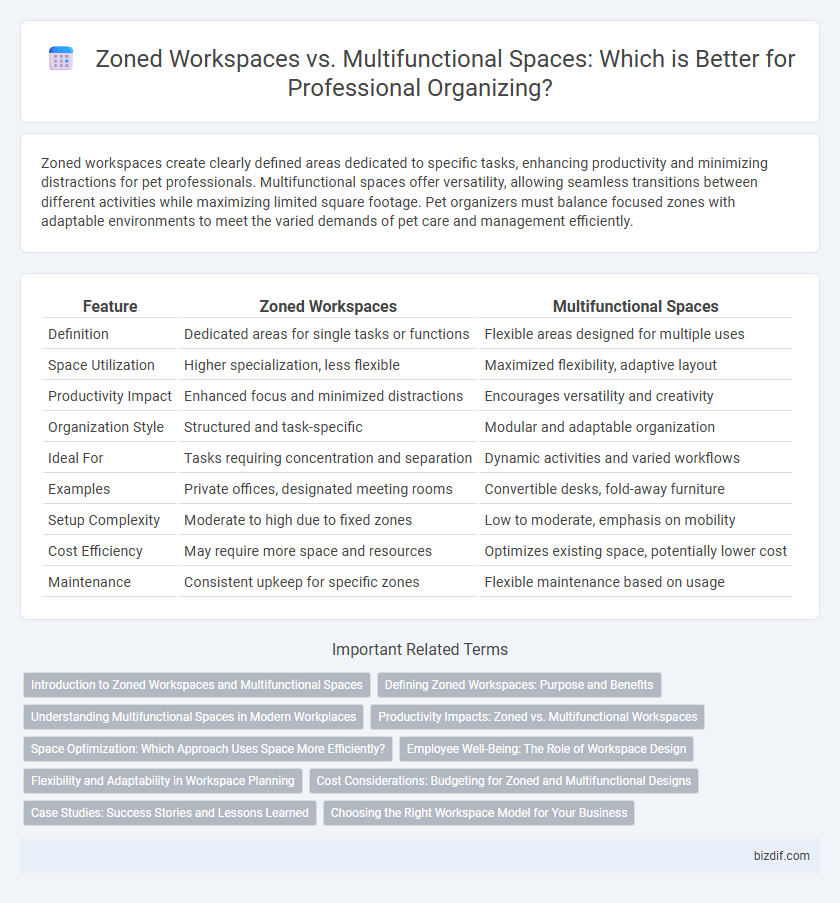Zoned workspaces create clearly defined areas dedicated to specific tasks, enhancing productivity and minimizing distractions for pet professionals. Multifunctional spaces offer versatility, allowing seamless transitions between different activities while maximizing limited square footage. Pet organizers must balance focused zones with adaptable environments to meet the varied demands of pet care and management efficiently.
Table of Comparison
| Feature | Zoned Workspaces | Multifunctional Spaces |
|---|---|---|
| Definition | Dedicated areas for single tasks or functions | Flexible areas designed for multiple uses |
| Space Utilization | Higher specialization, less flexible | Maximized flexibility, adaptive layout |
| Productivity Impact | Enhanced focus and minimized distractions | Encourages versatility and creativity |
| Organization Style | Structured and task-specific | Modular and adaptable organization |
| Ideal For | Tasks requiring concentration and separation | Dynamic activities and varied workflows |
| Examples | Private offices, designated meeting rooms | Convertible desks, fold-away furniture |
| Setup Complexity | Moderate to high due to fixed zones | Low to moderate, emphasis on mobility |
| Cost Efficiency | May require more space and resources | Optimizes existing space, potentially lower cost |
| Maintenance | Consistent upkeep for specific zones | Flexible maintenance based on usage |
Introduction to Zoned Workspaces and Multifunctional Spaces
Zoned workspaces divide an area into specific sections designated for particular tasks, enhancing focus and productivity by minimizing distractions. Multifunctional spaces integrate various activities within a single area, optimizing space efficiency and flexibility for changing needs. Both approaches aim to create organized environments tailored to work styles and spatial constraints.
Defining Zoned Workspaces: Purpose and Benefits
Zoned workspaces are designated areas within an office or home environment created to support specific tasks and improve focus and productivity. By clearly separating functions such as computer work, meetings, and creative brainstorming, these zones reduce distractions and streamline workflow. This intentional spatial organization enhances efficiency and mental clarity, promoting a more organized and effective professional environment.
Understanding Multifunctional Spaces in Modern Workplaces
Multifunctional spaces in modern workplaces optimize productivity by seamlessly integrating diverse activities within a single environment, reducing the need for separate rooms. These areas often incorporate adjustable furniture and technology to support varied tasks, from meetings to individual focused work. Emphasizing flexibility and adaptability, multifunctional workspaces cater to dynamic workflows and evolving organizational needs.
Productivity Impacts: Zoned vs. Multifunctional Workspaces
Zoned workspaces enhance productivity by minimizing distractions and creating dedicated areas for specific tasks, promoting focus and task completion. Multifunctional spaces offer flexibility but may increase cognitive load and interruptions, reducing overall efficiency. Research shows that clearly defined zones boost task performance and reduce mental fatigue compared to blended work environments.
Space Optimization: Which Approach Uses Space More Efficiently?
Zoned workspaces use dedicated areas for specific tasks, minimizing distractions and maximizing focus, which enhances productivity in targeted activities. Multifunctional spaces, designed to serve several purposes within the same area, provide greater flexibility and adapt to various work needs without requiring additional square footage. Space optimization favors multifunctional setups in smaller environments, whereas zoned workspaces offer efficiency in larger offices by clearly defining functional boundaries.
Employee Well-Being: The Role of Workspace Design
Zoned workspaces, designed with specific functions in mind, enhance employee well-being by reducing distractions and increasing focus, which leads to higher productivity and job satisfaction. Multifunctional spaces offer flexibility and encourage collaboration, supporting diverse work styles and promoting social interaction, essential for mental health and creativity. Balancing these designs within an office optimizes employee comfort and engagement, fostering a healthier and more dynamic work environment.
Flexibility and Adaptability in Workspace Planning
Zoned workspaces enhance productivity by creating dedicated areas tailored to specific tasks, promoting focus and minimizing distractions. Multifunctional spaces maximize adaptability, allowing users to switch between activities seamlessly, optimizing limited square footage. Prioritizing flexibility in workspace planning supports diverse work styles and evolving needs, enabling efficient use of physical resources while fostering creativity and collaboration.
Cost Considerations: Budgeting for Zoned and Multifunctional Designs
Zoned workspaces often require higher upfront costs due to dedicated furniture and specialized storage solutions tailored for each function, impacting overall budgeting considerations. Multifunctional spaces optimize cost-efficiency by utilizing adaptable furniture and shared resources, reducing the need for multiple setups and decreasing total expenses. Careful assessment of space requirements and intended use determines whether initial investment in zoned or multifunctional designs offers better long-term financial benefits.
Case Studies: Success Stories and Lessons Learned
Case studies in professional organizing reveal that zoned workspaces enhance focus and productivity by clearly defining areas for specific tasks, as seen in corporate offices where designated zones cut distractions by 40%. Multifunctional spaces offer flexibility, supporting diverse activities but require meticulous planning to prevent clutter and chaos, demonstrated by startups that improved efficiency by 25% after implementing adaptable layouts. Lessons learned emphasize balancing purpose-driven zones with adaptable elements to optimize functionality in varied work environments.
Choosing the Right Workspace Model for Your Business
Selecting the right workspace model hinges on your business needs, with zoned workspaces providing specialized areas that enhance focus and efficiency for specific tasks. Multifunctional spaces offer flexibility, accommodating diverse activities and promoting collaboration, ideal for dynamic or smaller teams. Evaluating work patterns, team size, and workflow complexity enables a strategic decision that maximizes productivity and organizational effectiveness.
zoned workspaces vs multifunctional spaces Infographic

 bizdif.com
bizdif.com